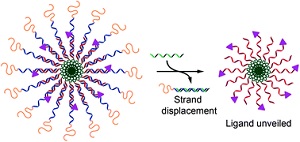 |
| Nanoparticles with a polymer coat that is removed when exposed to a specific genetic sequence.--Courtesy of EPSRC |
A nanoparticle with a specific code mechanism for release could have broad implications for targeted drug delivery, allowing drug-carrying vehicles to issue their payload upon contact with a specific biomarker. Now, researchers have developed a nanoparticle that uses coded DNA as this kind of "on-off" switch, which could have many possible uses.
A team from the University of Nottingham's School of Pharmacy in the U.K. is working on a smart delivery and diagnostics system that is wrapped in a polymer "disguise." This is held on until the particle reaches a complementary genetic sequence that reveals what is inside. Early on, this type of molecule might lend itself more to diagnostics, but the scientists hope to someday encapsulate drugs within the system, according to a report from the Engineering and Physical Sciences Research Council (EPSRC), which helped fund the project. The research was published recently in the journal Nanoparticles.
"These types of switchable nanoparticles could be extremely versatile," lead author Cameron Alexander said in a statement. "As well as initial detection of a medical condition, they could be used to monitor the progress of diseases and courses of treatment, or adapted to deliver potent drugs at particular locations in a patient's body."
The system itself is a self-contained nanoparticle with numerous DNA strands extending from its surface, each with a polymer attached to the end. These polymers form a sort of umbrella that keeps the inner particle from exposure. When it reaches the site of an infection or disease, a specific sequence attaches to the polymer and pulls it away from the nanoparticle. Then, when its cover is removed, the diagnostic or drug can begin acting on the site.
So far, the researchers have shown that the nanoparticle works when exposed to specific molecular signals in the lab, but getting it to work in such a precise manner in vivo is a different story. Early iterations of the system could be used to simply detect infections with a specific genetic code in blood or spit, according to the report.
From there, the team hopes to move toward highly targeted drug delivery.
- here's the EPSRC report
- and here's the abstract